Abstract
Upon testing the ability of several strains of mice to elicit esterolytic antibodies after immunization with a p-nitrobenzyl phosphonate hapten, we have found that the occurrence of catalytic antibodies in SJL and MRL/lpr autoimmune mice is dramatically higher than in normal mouse strains (e.g., the wild-type MRL/++ or BALB/c). Fewer than 10 catalytic clones are usually obtained from a single fusion of lymphocytes taken from normal mice, whereas several hundred catalytic clones are obtained in SJL or MRL/lpr mice. Differences in the numbers of hapten-binding clones do not account for the high occurrences of catalytic clones in these strains. This phenomenon prevailed in the early responses; in both SJL and MRL/lpr mice a significant decline in the appearance of catalytic clones was observed after multiple immunizations. Esterolytic antibodies were not found in MRL/lpr mice immunized with haptens that do not mimic the transition state for the hydrolysis of the ester substrate (e.g., with a substrate analog). The catalytic antibodies manifest high specificity to the antigen and variability in their binding and catalytic properties. The use of autoimmunity-prone mice may greatly expand the repertoire of catalytic clones elicited against a transition-state analog hapten. More intriguing is the possible linkage between autoimmunity and the appearance of catalytic antibodies. These results suggest that there is normally a selection against the expression of certain variable genes encoding antibodies with catalytic activity.
Full text
PDF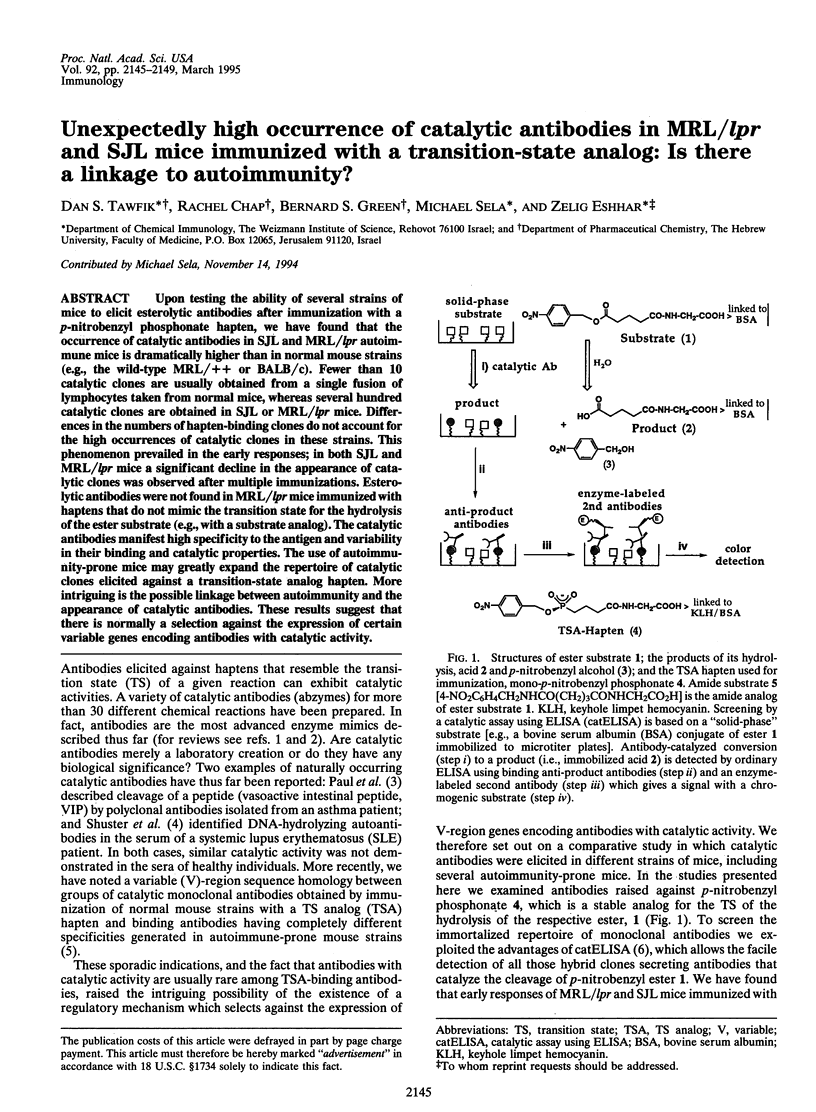
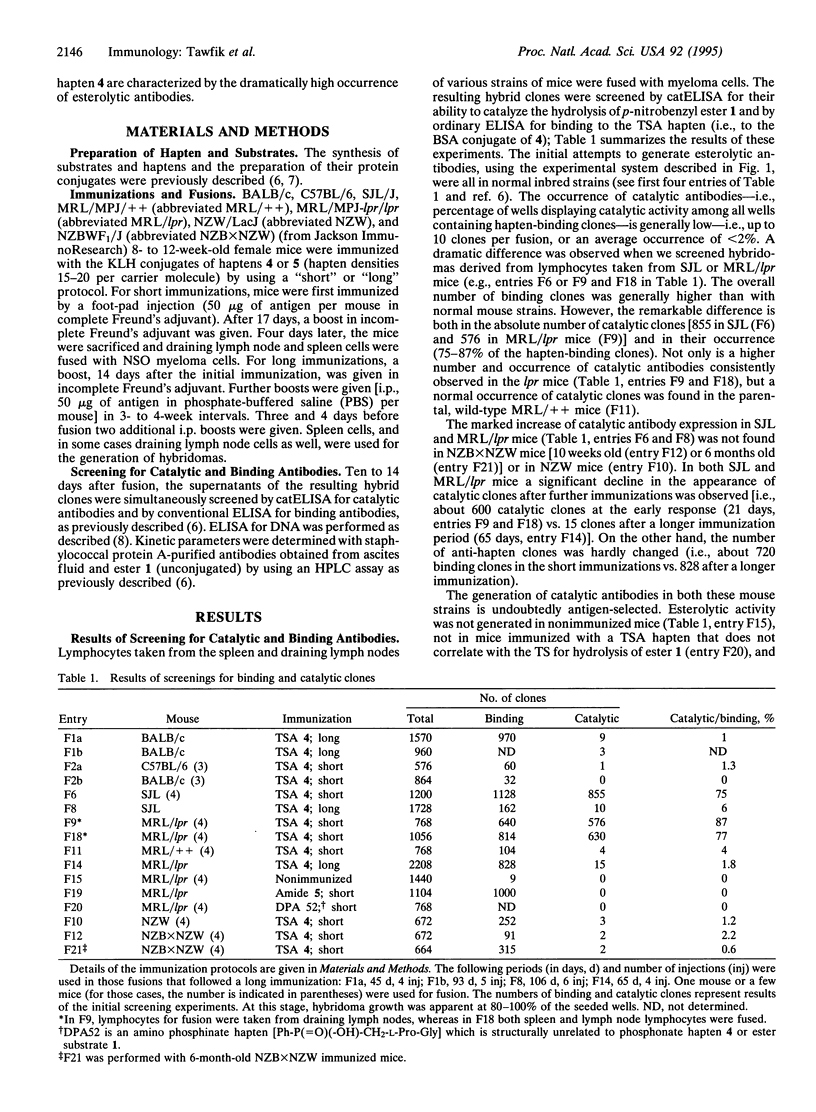
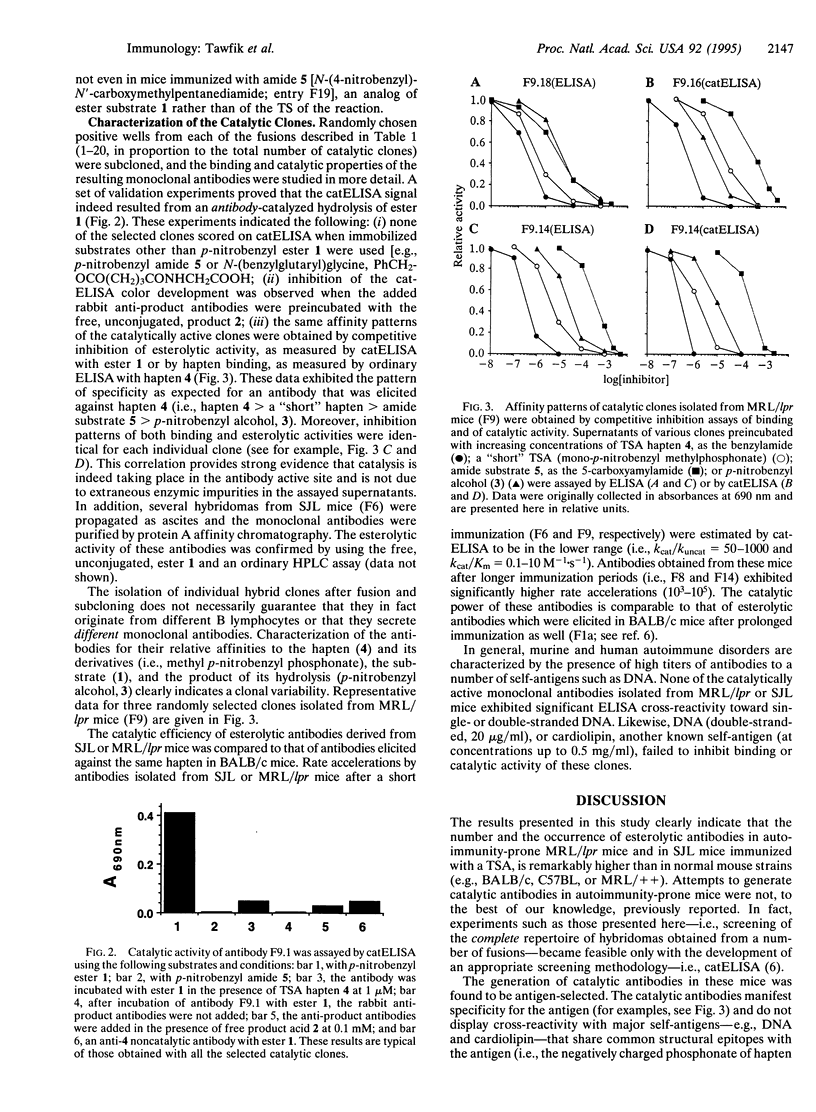
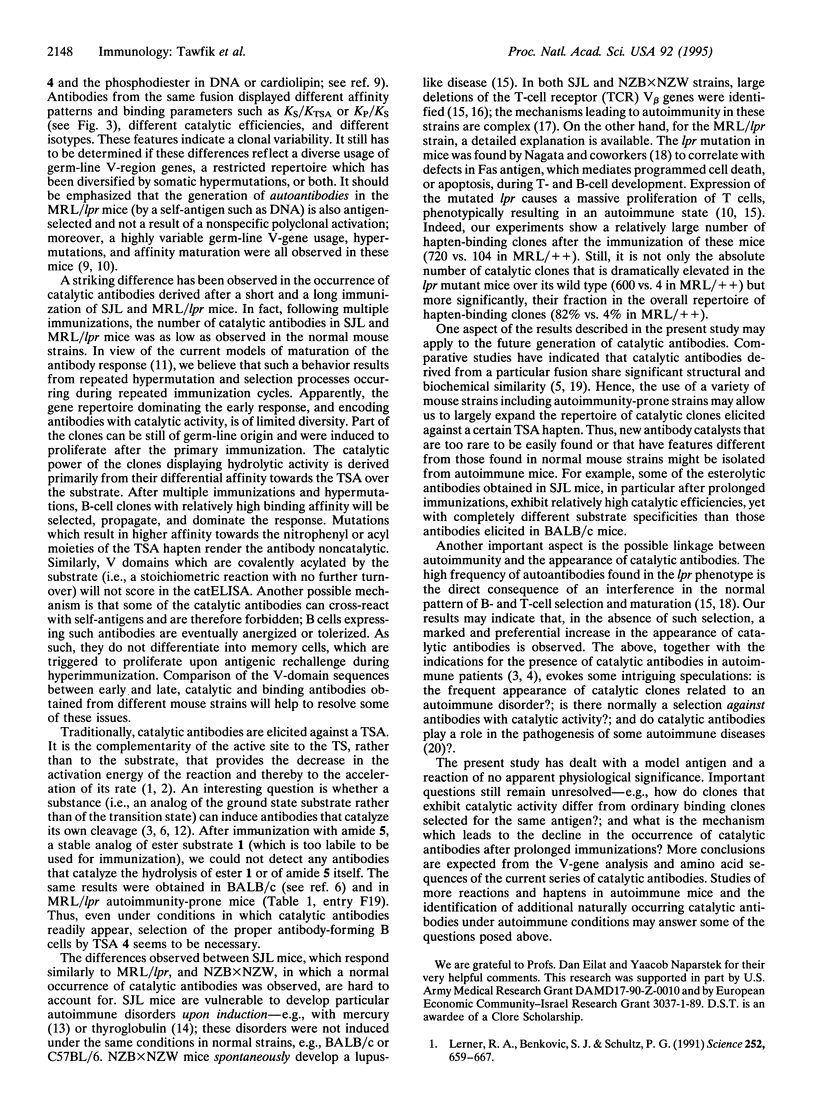
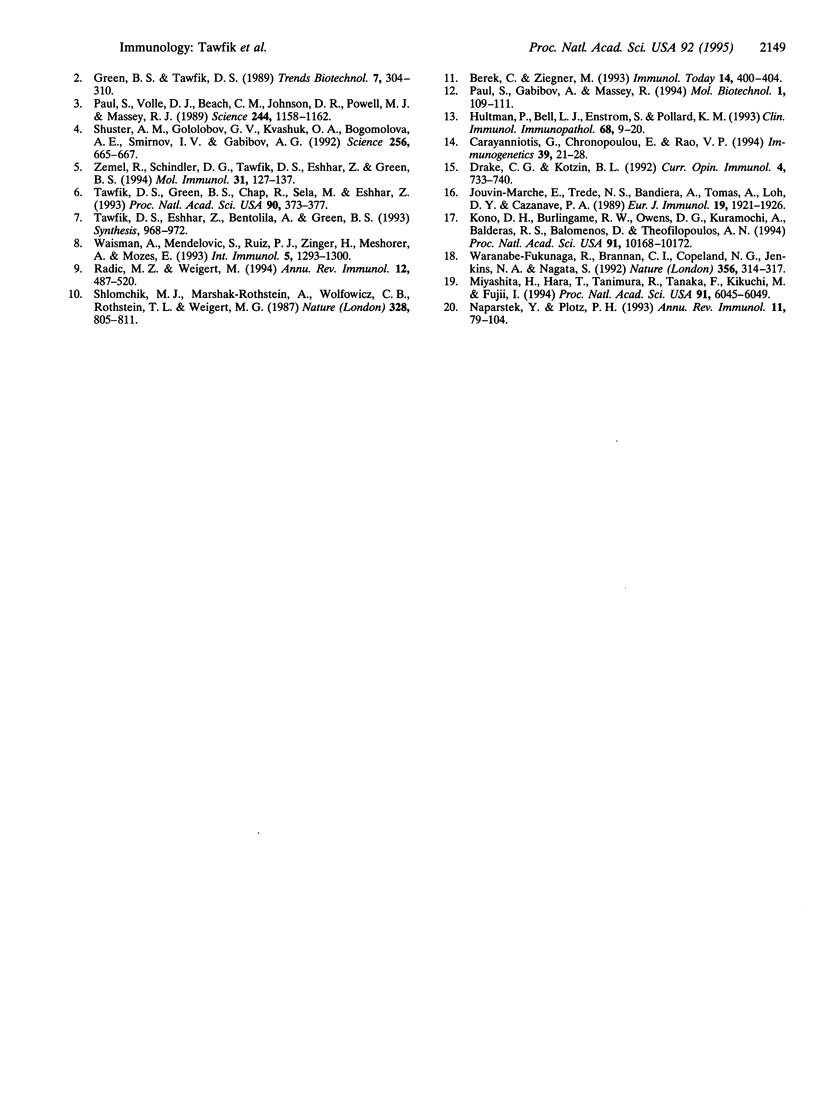
Selected References
These references are in PubMed. This may not be the complete list of references from this article.
- Berek C., Ziegner M. The maturation of the immune response. Immunol Today. 1993 Aug;14(8):400–404. doi: 10.1016/0167-5699(93)90143-9. [DOI] [PubMed] [Google Scholar]
- Carayanniotis G., Chronopoulou E., Rao V. P. Distinct genetic pattern of mouse susceptibility to thyroiditis induced by a novel thyroglobulin peptide. Immunogenetics. 1994;39(1):21–28. doi: 10.1007/BF00171793. [DOI] [PubMed] [Google Scholar]
- Drake C. G., Kotzin B. L. Genetic and immunological mechanisms in the pathogenesis of systemic lupus erythematosus. Curr Opin Immunol. 1992 Dec;4(6):733–740. doi: 10.1016/0952-7915(92)90054-i. [DOI] [PubMed] [Google Scholar]
- Hultman P., Bell L. J., Eneström S., Pollard K. M. Murine susceptibility to mercury. II. autoantibody profiles and renal immune deposits in hybrid, backcross, and H-2d congenic mice. Clin Immunol Immunopathol. 1993 Jul;68(1):9–20. doi: 10.1006/clin.1993.1088. [DOI] [PubMed] [Google Scholar]
- Jouvin-Marche E., Trede N. S., Bandeira A., Tomas A., Loh D. Y., Cazenave P. A. Different large deletions of T cell receptor V beta genes in natural populations of mice. Eur J Immunol. 1989 Oct;19(10):1921–1926. doi: 10.1002/eji.1830191024. [DOI] [PubMed] [Google Scholar]
- Kono D. H., Burlingame R. W., Owens D. G., Kuramochi A., Balderas R. S., Balomenos D., Theofilopoulos A. N. Lupus susceptibility loci in New Zealand mice. Proc Natl Acad Sci U S A. 1994 Oct 11;91(21):10168–10172. doi: 10.1073/pnas.91.21.10168. [DOI] [PMC free article] [PubMed] [Google Scholar]
- Lerner R. A., Benkovic S. J., Schultz P. G. At the crossroads of chemistry and immunology: catalytic antibodies. Science. 1991 May 3;252(5006):659–667. doi: 10.1126/science.2024118. [DOI] [PubMed] [Google Scholar]
- Miyashita H., Hara T., Tanimura R., Tanaka F., Kikuchi M., Fujii I. A common ancestry for multiple catalytic antibodies generated against a single transition-state analog. Proc Natl Acad Sci U S A. 1994 Jun 21;91(13):6045–6049. doi: 10.1073/pnas.91.13.6045. [DOI] [PMC free article] [PubMed] [Google Scholar]
- Naparstek Y., Plotz P. H. The role of autoantibodies in autoimmune disease. Annu Rev Immunol. 1993;11:79–104. doi: 10.1146/annurev.iy.11.040193.000455. [DOI] [PubMed] [Google Scholar]
- Paul S., Gabibov A., Massey R. Catalytic antibodies. Conference overview. Mol Biotechnol. 1994 Feb;1(1):109–111. doi: 10.1007/BF02821514. [DOI] [PubMed] [Google Scholar]
- Paul S., Volle D. J., Beach C. M., Johnson D. R., Powell M. J., Massey R. J. Catalytic hydrolysis of vasoactive intestinal peptide by human autoantibody. Science. 1989 Jun 9;244(4909):1158–1162. doi: 10.1126/science.2727702. [DOI] [PubMed] [Google Scholar]
- Radic M. Z., Weigert M. Genetic and structural evidence for antigen selection of anti-DNA antibodies. Annu Rev Immunol. 1994;12:487–520. doi: 10.1146/annurev.iy.12.040194.002415. [DOI] [PubMed] [Google Scholar]
- Shlomchik M. J., Marshak-Rothstein A., Wolfowicz C. B., Rothstein T. L., Weigert M. G. The role of clonal selection and somatic mutation in autoimmunity. 1987 Aug 27-Sep 2Nature. 328(6133):805–811. doi: 10.1038/328805a0. [DOI] [PubMed] [Google Scholar]
- Shuster A. M., Gololobov G. V., Kvashuk O. A., Bogomolova A. E., Smirnov I. V., Gabibov A. G. DNA hydrolyzing autoantibodies. Science. 1992 May 1;256(5057):665–667. doi: 10.1126/science.1585181. [DOI] [PubMed] [Google Scholar]
- Tawfik D. S., Green B. S., Chap R., Sela M., Eshhar Z. catELISA: a facile general route to catalytic antibodies. Proc Natl Acad Sci U S A. 1993 Jan 15;90(2):373–377. doi: 10.1073/pnas.90.2.373. [DOI] [PMC free article] [PubMed] [Google Scholar]
- Waisman A., Mendlovic S., Ruiz P. J., Zinger H., Meshorer A., Mozes E. The role of the 16/6 idiotype network in the induction and manifestations of systemic lupus erythematosus. Int Immunol. 1993 Oct;5(10):1293–1300. doi: 10.1093/intimm/5.10.1293. [DOI] [PubMed] [Google Scholar]
- Watanabe-Fukunaga R., Brannan C. I., Copeland N. G., Jenkins N. A., Nagata S. Lymphoproliferation disorder in mice explained by defects in Fas antigen that mediates apoptosis. Nature. 1992 Mar 26;356(6367):314–317. doi: 10.1038/356314a0. [DOI] [PubMed] [Google Scholar]
- Zemel R., Schindler D. G., Tawfik D. S., Eshhar Z., Green B. S. Differences in the biochemical properties of esterolytic antibodies correlate with structural diversity. Mol Immunol. 1994 Feb;31(2):127–137. doi: 10.1016/0161-5890(94)90085-x. [DOI] [PubMed] [Google Scholar]


